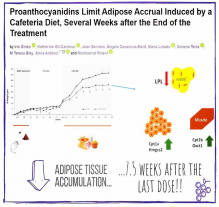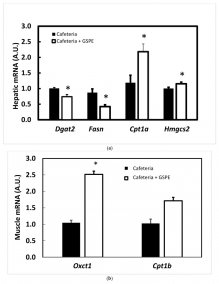Recently published results: Proanthocyanidins Limit Adipose Accrual Induced by a Cafeteria Diet
Seven weeks after the last GSPE administration there was a limitation in adipose accrual that might be mediated by an inhibition of the gene expression of the adipose tissue Lpl
Abstract
A dose of proanthocyanidins with satiating properties proved to be able to limit body weight increase several weeks after administration under exposure to a cafeteria diet. Here we describe some of the molecular targets and the duration of the effects. We treated rats with 500 mg grape seed proanthocyanidin extract (GSPE)/kg BW for ten days. Seven or seventeen weeks after the last GSPE dose, while animals were on a cafeteria diet, we used reverse transcriptase-polymerase chain reaction (RT-PCR) to measure the mRNA of the key energy metabolism enzymes from the liver, adipose depots and muscle. We found that a reduction in the expression of adipose Lpl might explain the lower amount of adipose tissue in rats seven weeks after the last GSPE dose. The liver showed increased expression of Cpt1a and Hmgs2 together with a reduction in Fasn and Dgat2. In addition, muscle showed a higher fatty oxidation (Oxct1 and Cpt1b mRNA). However, after seventeen weeks, there was a completely different gene expression pattern. At the conclusion of the study, seven weeks after the last GSPE administration there was a limitation in adipose accrual that might be mediated by an inhibition of the gene expression of the adipose tissue Lpl. Concomitantly there was an increase in fatty acid oxidation in liver and muscle.


